Understanding NSO Stock Options and Taxes: A Guide for Startup Employees
NSO stock options
If you work for a tech startup, you may have non-qualified stock options (NSOs).
Hopefully they’ll make you money someday. But how much you’ll make depends for a good part on how they’re taxed.
It isn’t easy to educate yourself on this. Most info isn’t specific to the tech startup situation, or it’s written in jargonese, or it’s too high-level to be practically useful.
That’s why we wrote this guide. An in-depth resource on NSO taxes and strategies, in plain English and with helpful visualizations.
Still got some questions? Always feel free to hit us up for a chat in the bottom-right.
TL;DR
NSOs are taxed when you exercise them, and then later when you make money with them (when your company exits and you sell your shares).
They don’t get taxed either when the company first grants you them, or when they vest.
Assuming that the company you work for:
- Keeps growing (so its 409A valuation increases over time)
- Manages to successfully exit (so you can sell your NSOs at a gain)
Then the key to minimizing your tax burden (both at exercise and at sale) is to exercise as early as possible.
Here’s why:
- The later you exercise, the more exercise tax you’ll owe
- If you exercise your NSOs at least a year prior to selling, you get a discount on your sale tax – and the earlier the exercise, the bigger the discount
Warning: when exercising your NSOs, your employer will withhold only some of the taxes. It’s up to you to pay the remainder to the IRS. This often surprises people.
(Want to know exactly how much you'll be taxed? Use our free Stock Option Tax Calculator for taxes on exercise).
What are NSOs?
Non-qualified stock options (or NSOs) are a type of stock option that does not ‘qualify’ for the same favorable tax treatment that other types of stock options (specifically ISOs) do.
ISO vs NSO Tax?
With NSOs you’re more likely to be taxed when you exercise them than with incentive stock options (ISOs). And if you are taxed, then it’s usually at a higher rate.
When you later make money with them you’re taxed again at an effective rate that’s often higher than with ISOs (more on that later).
The one advantage of NSOs is that how they are taxed is a bit more straightforward and easier to understand than with ISOs. Although we’re not gonna lie – it’s still pretty complex.
The big picture: what’s the best tax strategy for your NSOs?
Before the rest of this guide dives into the details, let’s take a holistic look.
If you work for a constantly growing startup that ends up succeeding, the best tax strategy could be to exercise your NSOs as early as possible.
That’s because:
- You may net up to 27% more through tax savings
- The earlier you exercise, the bigger the tax savings
- The earlier you exercise, the less upfront cash you need to exercise
Here’s a real-world example:
Say you join a startup and get 15,000 NSOs with a $3 strike price. Eventually, the company IPOs and you get to sell the shares for $150 each.
Over time, the 409A valuation (also known as fair market value) of your company grows.
Say this is the timeline:
- Year 1: You join the company when the 409A valuation is $3
- Year 2: 409A grows to $35
- Year 3: 409A grows to $75
- Year 4: The company IPOs, and you sell your shares for $150
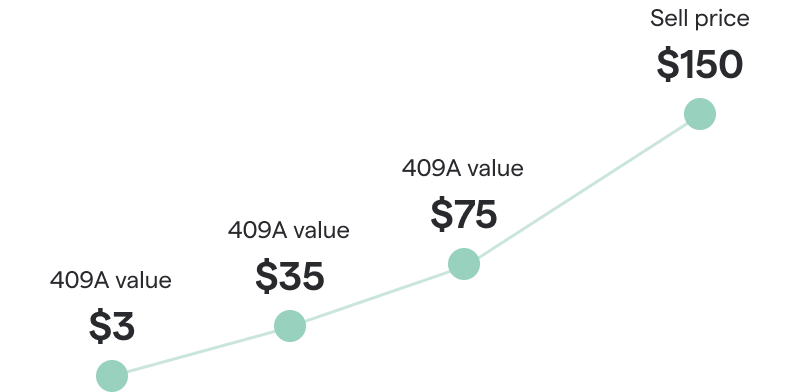
Then this gives 5 distinct moments at which you could exercise:
- A: While the 409A is $3
- B: While the 409A is $35
- C: While the 409A is $75, but you exercise more than 12 months before the day you sell
- D: While the 409A is $75, but you exercise less than 12 months before the day you sell
- E: You exercise on the same day as when you sell
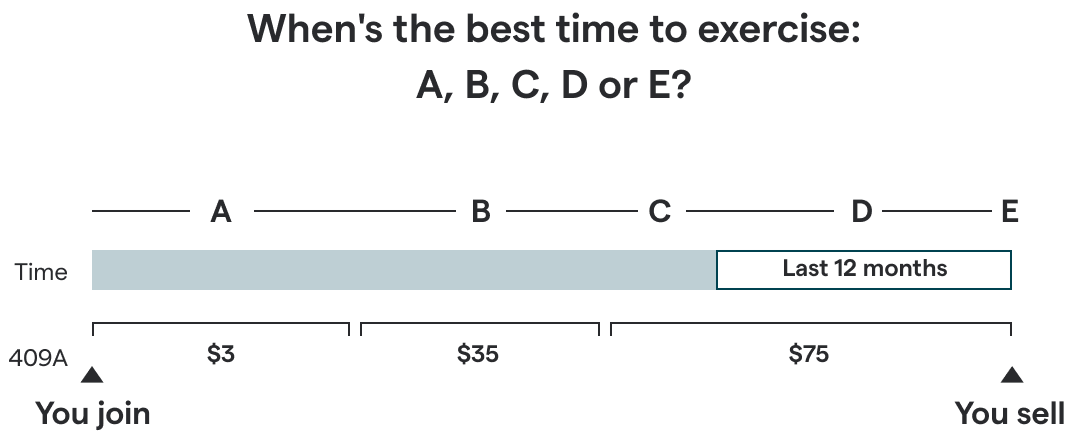
When should you exercise your NSOs?
You could exercise at any of these points in time – but your tax situation would be different at each.
Depending on when you exercise, the amount of cash you need to exercise as well as your net gain change.
Here’s the amount of cash you’d need to exercise at A, B, C, D or E:
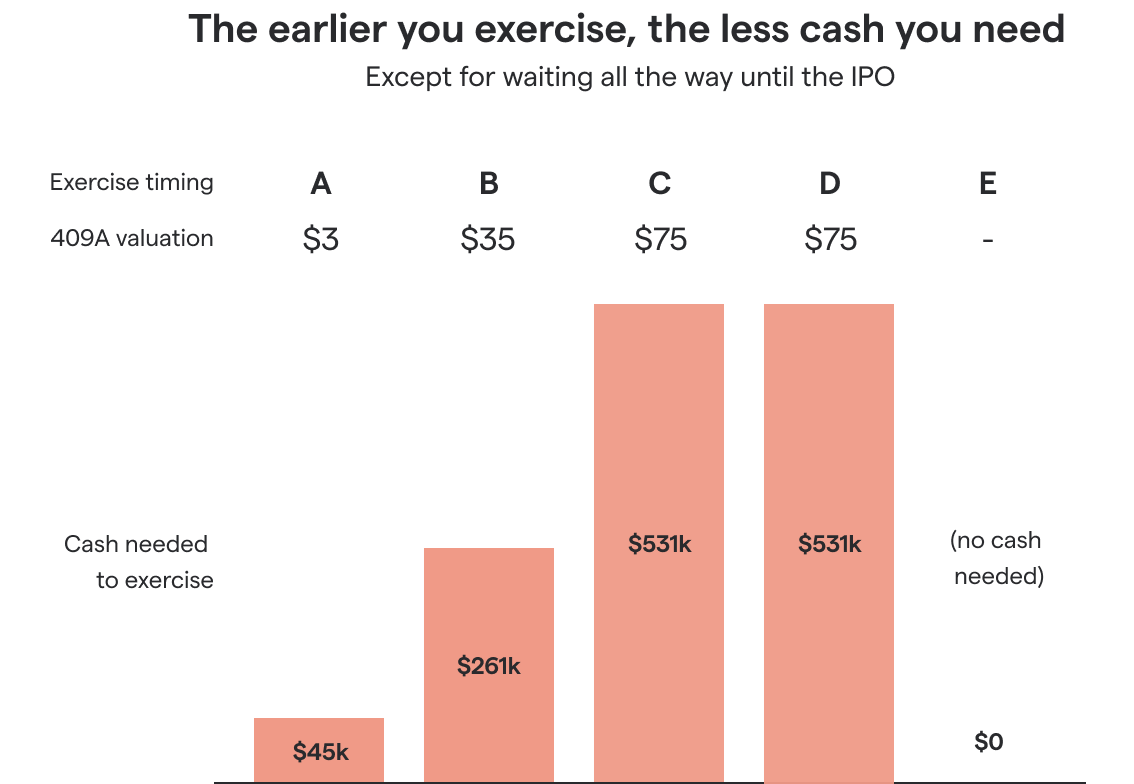
If you wait all the way until you sell (point E), you don’t need any cash to exercise — because you can cover the costs with your proceeds.
But if you exercise before selling, you need to pay out of pocket.
And the higher the 409A, the more cash you need, because you trigger a higher tax bill.
So why would anyone exercise before selling? Because otherwise you’d end up with the lowest possible net gain:
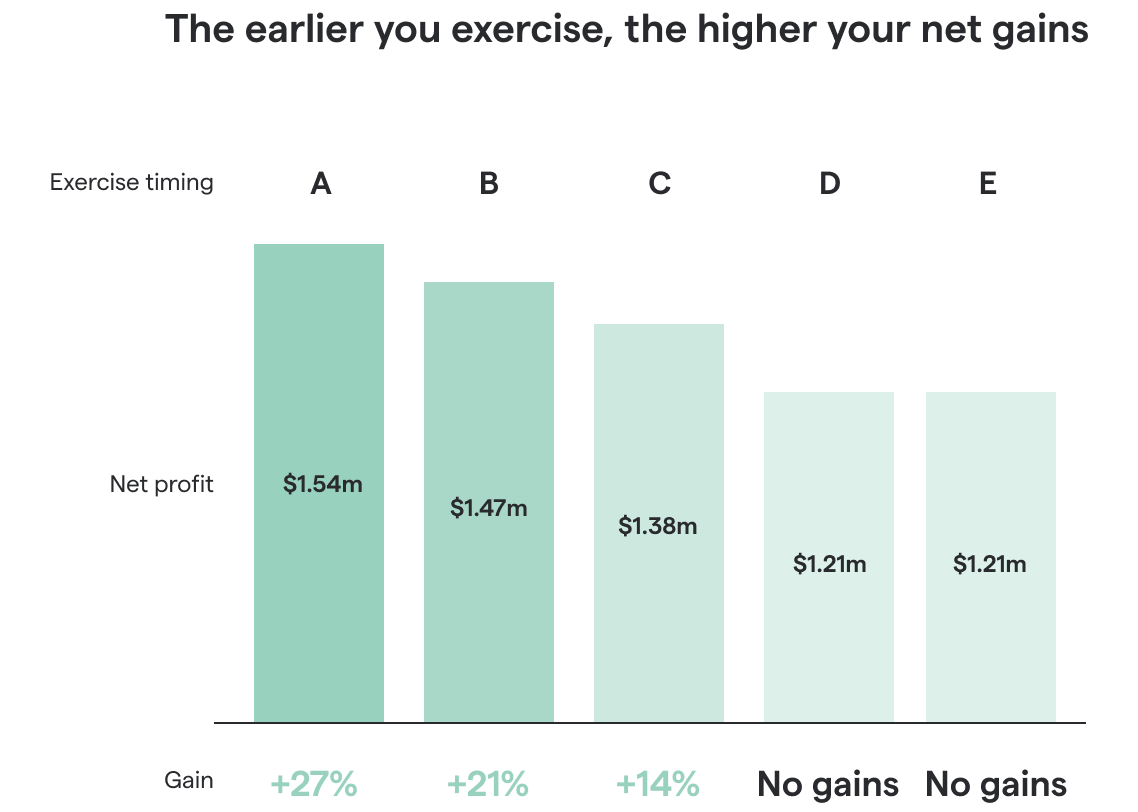
If you exercise at least 12 months prior to selling – which is the case at A, B and C – your net gain is higher.
And the lower the 409A when you exercise, the higher your net gain gets.
In summary, here's what happens depending on when you exercise:
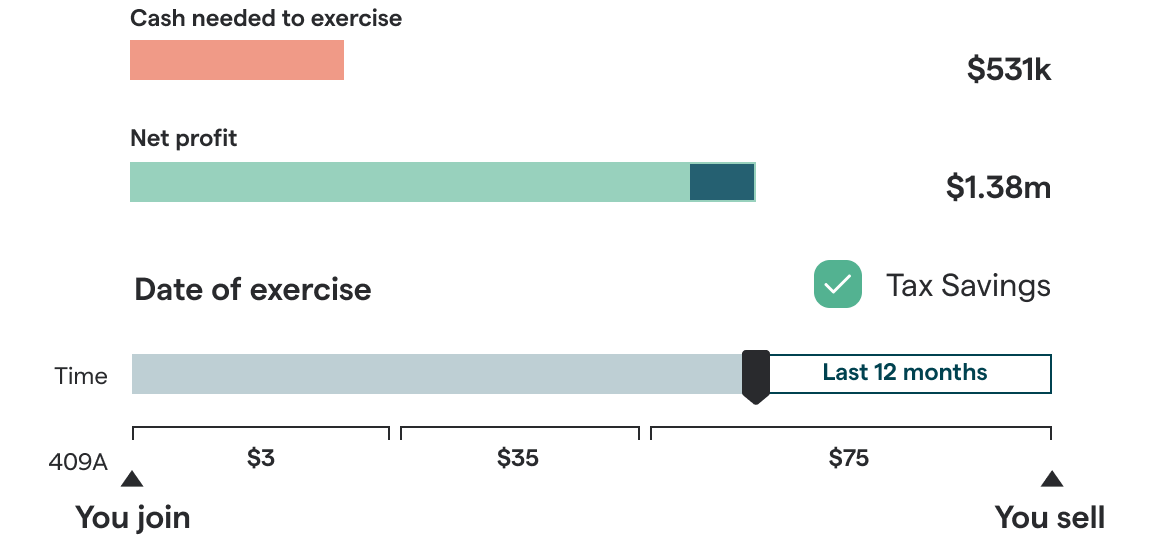
Why it works like this 🤔
Normally, the money you make from NSOs is taxed just like your salary.
But if you exercise your NSOs at least 12 months before selling them, you get a tax discount. That can increase your net gain by up to 27% (the above image).
The problem?
As soon as you exercise, you have to prepay a part of these taxes. So exercising before IPO is a trade-off: it means paying some tax now so you’ll pay less tax overall.
Things depend on the 409A valuation of the company at the time of your exercise:
- The higher the 409A, the smaller the overall tax discount you get
- The higher the 409A, the more tax you need to prepay
Generally, as long as a company is growing, its 409A increases over time.
So, in our example, this is what the taxes do depending on when you exercise:
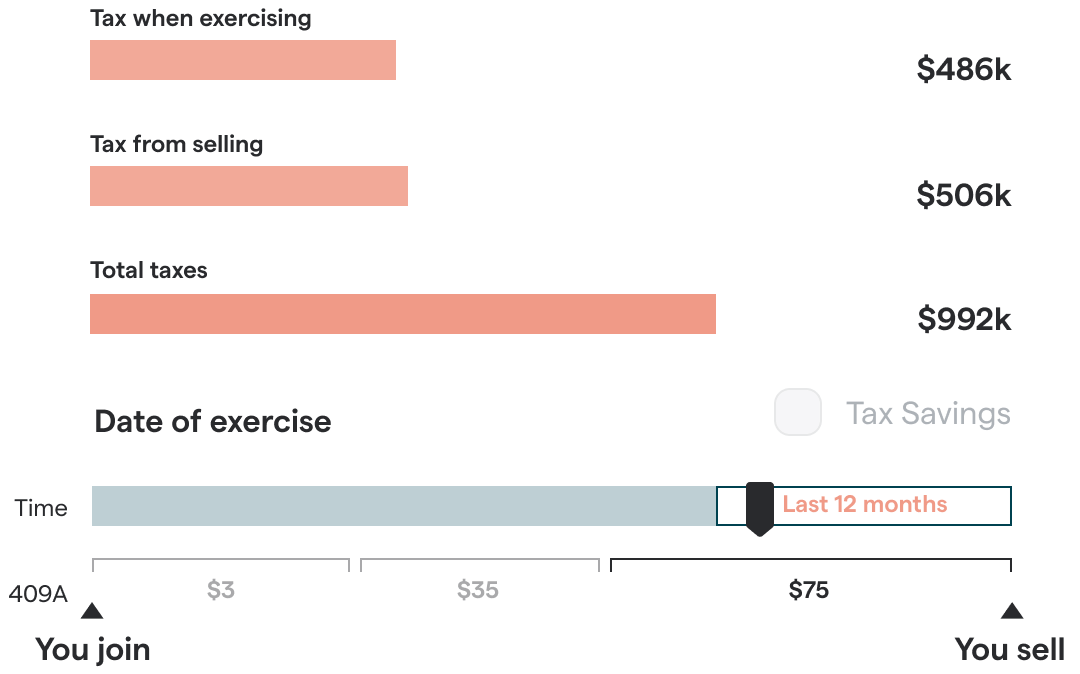
In conclusion:
If you work for a constantly growing startup, then the longer you wait to exercise your NSOs, the less net gain you’ll end up with and the more cash you’ll need to do it.
What exactly is a 409A valuation?
The 409A valuation (a.k.a. fair market value) is an appraisal of the value of a company share for tax purposes. Your employer is required to have it re-assessed by a third party at least once a year – or when something impactful happens, like a new funding round.
The 409A reflects company growth. Is the company in a better place than last time? Then the 409A will rise. So a higher 409A is a good sign for the company, but it’s bad for your tax situation if you haven’t yet exercised.
More on 409A valuations here.
What if exercising my NSOs is too expensive?
Of course, $261k or even $531k is a huge amount to pay for your NSOs.
Unfortunately, these aren’t uncommon numbers for employees at the most successful and high-growth startups.
See, for example, how much these Snowflake and DoorDash employees had to pay. Among Secfi users, the average exercise cost is $505,923.
Even if you have that kind of money, putting your personal savings on the line is risky since it’s not guaranteed that your company will actually manage to reach a successful exit
So what do you do if you still want that tax savings? Or what if you recently left your company and now have a deadline to exercise your NSOs?
That’s exactly why exercise financing exists, which we offer at Secfi.
Here’s how our exercise financing works:
- We cover your exercise costs (including taxes)
- You pay us back after your company exits
- It’s non-recourse, meaning you don't risk your personal assets – if the exit never happens, you won’t have to pay us back
- You stay the owner of your shares – you’re not selling them to us or anything like that
We make money only if there is a successful exit. If there is, you’ll pay us back more than the original amount. (But because of the tax savings, you’re often still at a net benefit vs not having exercised.)
If there’s no exit, you don’t owe us anything (and we’ll take the hit).
See if exercise financing is available for you, and at what rates.
Is it always better to exercise my NSOs as early as possible?
No. In the example, we made two assumptions:
1. Your company successfully exits (i.e. you get to sell your NSOs at a gain)
2. The 409A valuation of your company keeps rising
Regarding #1, most startups never get to that point.
That’s why exercising early on is risky. If the company later goes out of business, you’ve lost the money you spent.
If you want to exercise your NSOs but don’t want to risk losing money, financing could be a solution.
Regarding #2, sometimes the 409A valuation of a company temporarily dips. This means you can exercise at a lower cost, so in that scenario waiting actually makes it cheaper.
It’s difficult to time this, however. If you are long-term optimistic about the company, you should expect the 409A valuation to go up – unless you foresee a specific reason why the company would take a hit in the short term.
Now that you’ve got the big picture, let’s dig into the details of just how NSOs are taxed...
So how exactly are NSOs taxed?
NSOs are taxed at ordinary income tax rates (the highest possible rate, just like your salary) twice:
- When you exercise them
- Then again when you make money with them after your company exits.
But as we already mentioned, usually the earlier you exercise, the less you’ll owe (especially for fast-growing companies).
That’s because some of your taxes convert from ordinary income rates to the lower long-term capital gains rates. More details on how this works are below.
Are NSOs taxed when initially granted?
No. There’s no tax due when your company initially grants you the NSOs (i.e. awards you with them).
Are NSOs taxed when they vest?
No. After the initial grant, most NSOs follow a vesting schedule that dictates when you actually ‘get’ them. But when they vest, there’s still no tax due.
How are NSOs taxed when exercised?
In short:
- You pay ordinary income tax rates on the difference between the strike price and the 409A valuation
- Your employer already withholds a part, but it’s the bare minimum (usually 25%)
- You have to pay the rest to the IRS yourself
- That last part often comes as a surprise, so watch out
Ordinary income tax rates are usually ~35-52% for our clients in California. We’ll assume 45% in this article – use our Stock Option Tax Calculator to get a personalized figure.
The costs of exercising an NSO, visualized:
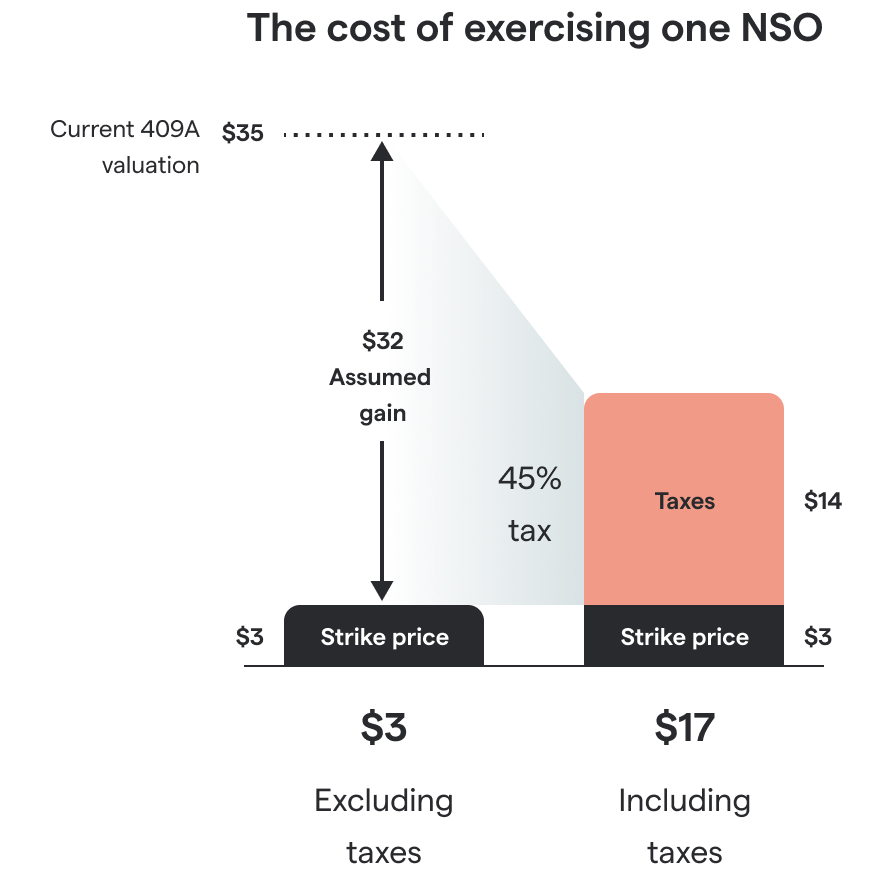
Let’s go through this step-by-step with some actual numbers.
Here’s a real-world example:
Say you have 15,000 NSOs with a $3 strike price, and the current 409A valuation is $35.
If you exercise one of these NSOs, you’ll pay your company $3 to buy a share.
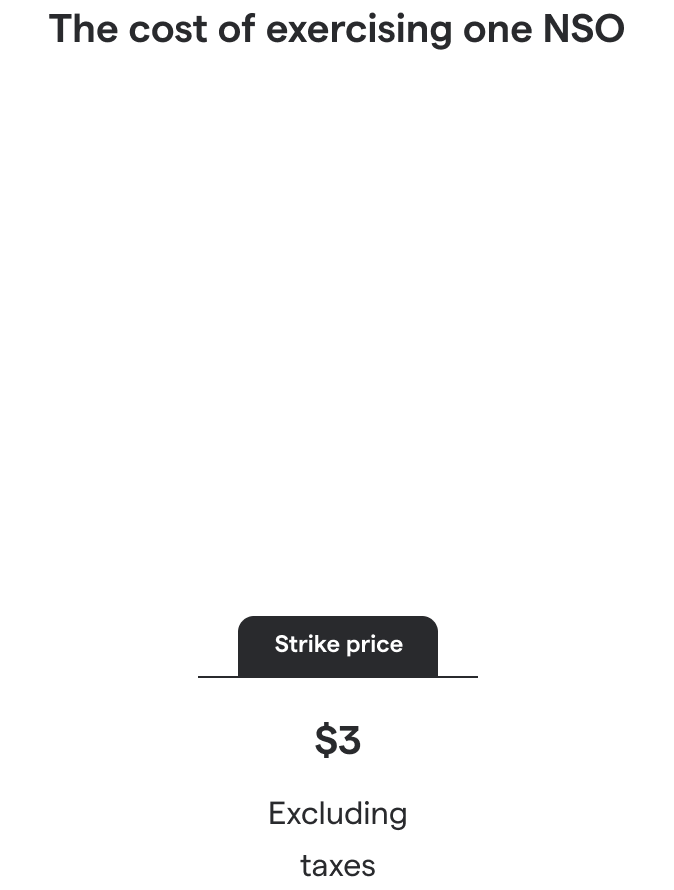
But the IRS views that share to be worth $35. The difference between the $3 and the $35 counts as a $32 phantom gain (also called the spread).
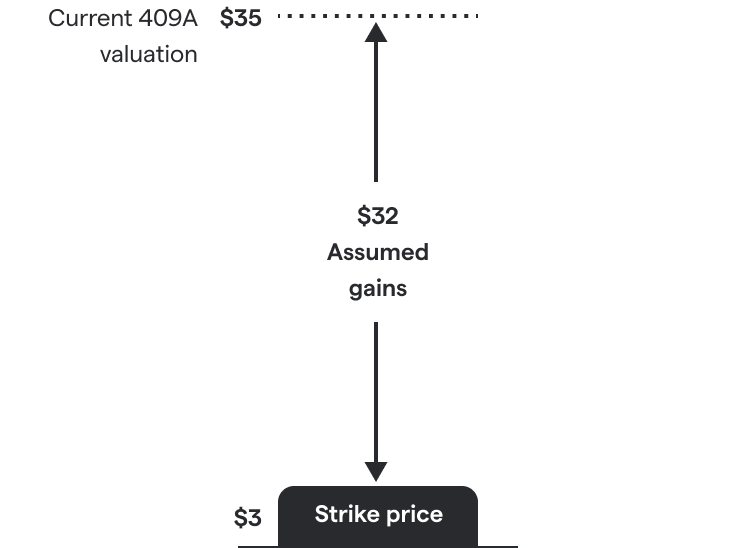
The phantom gain is taxed at ordinary income rates. So 45% of $32 is $14, which means you’ll pay $17 to exercise each NSO.

Say you decide to exercise all 15,000 NSOs. Then:
- You’re paying the company $45,000 to buy shares (15,000 × $3 strike price)
- The value of the shares is $525,000 according to the 409A valuation (15,000 × $35)
- You’re making a $480,000 phantom gain ($525,000 − $45,000)
- Your tax liability is $216,000 ($480,000 × 45%)
Including taxes and the strike price, your exercise costs are $261,000 ($216,000 + $45,000).
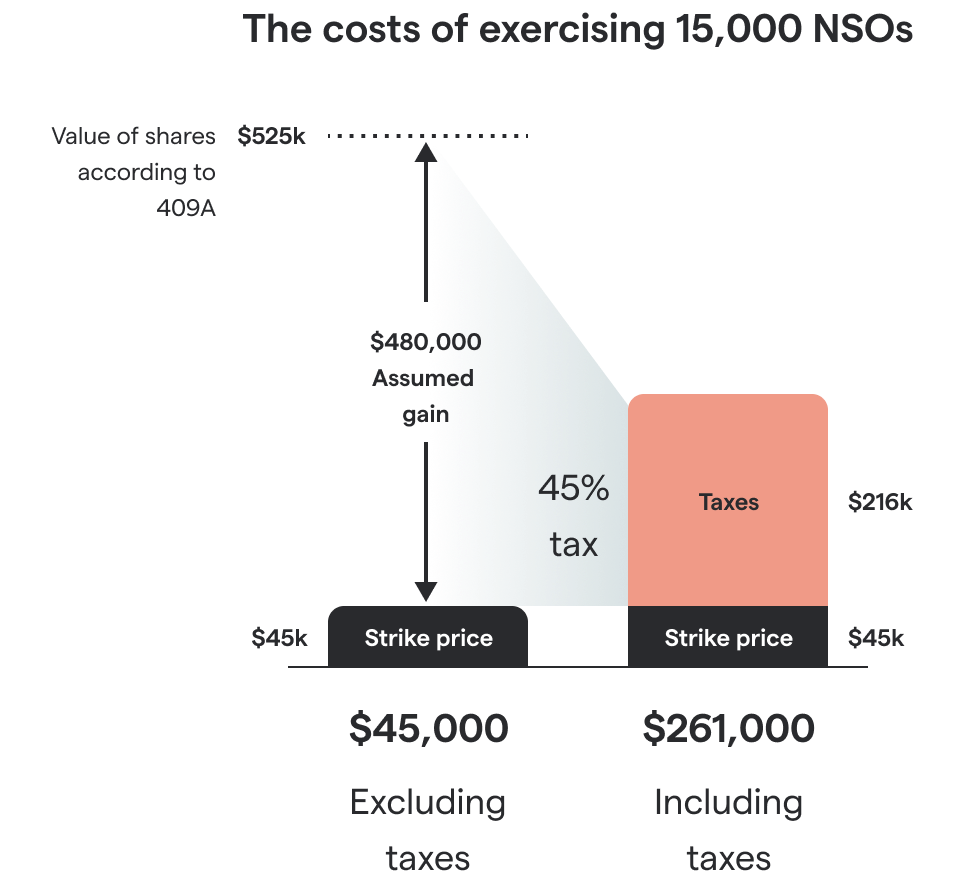
While that’s already more than most people realize they’ll have to pay, there are a few additional things to watch out for:
Warning #1: your employer will not yet charge you the full amount
Because the IRS counts this ‘gain’ as income, your employer is required to withhold taxes on it.
But since your employer hasn’t ‘paid’ you anything, they charge you a part of the taxes whenever your tax liability exceeds your salary.
And there’s an additional catch:
Your employer usually only charges you the bare minimum, say 25%.
Many employees think that’s all they owe. But you still owe the other ~20%, and it’s up to you to pay this to the IRS.
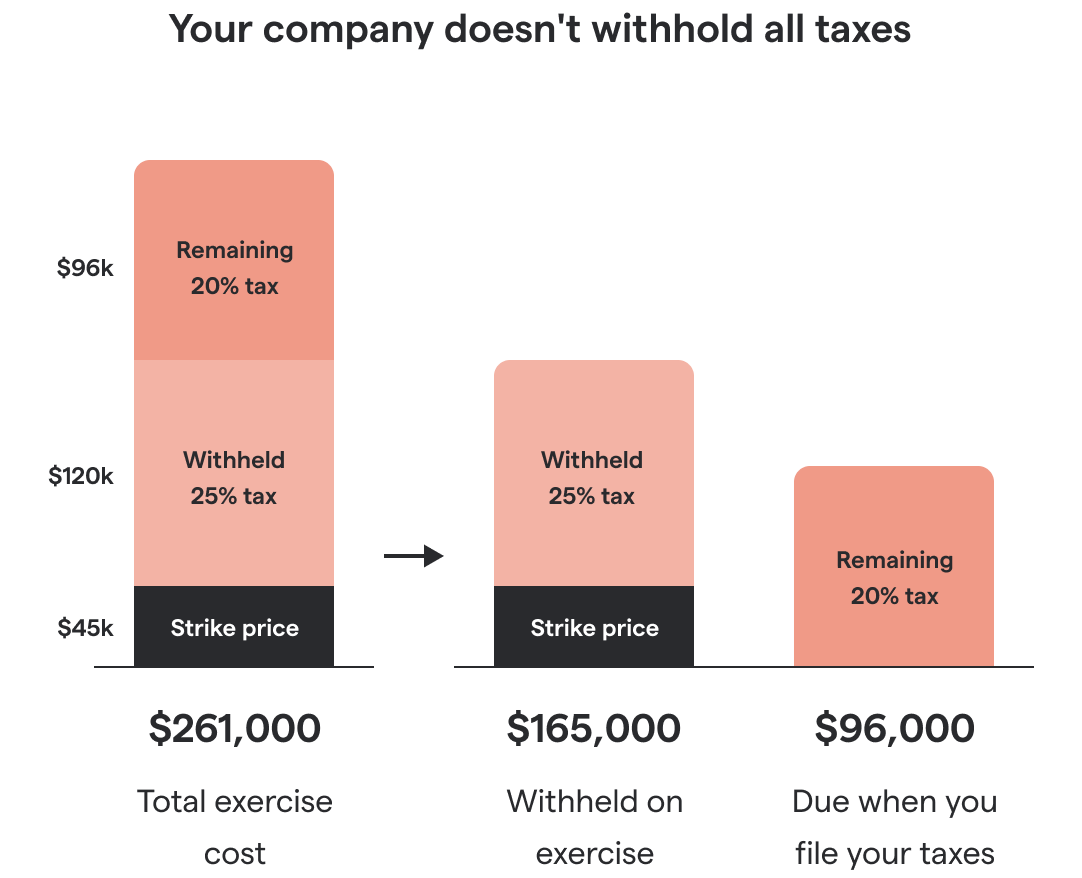
We’ve seen cases of people not realizing this and scrambling to come up with an extra $100K when taxes are due. Make sure to figure out your full tax liability before exercising.
Warning #2: the later you exercise, the higher your tax liability can become
If your company keeps growing – like successful startups do – exercising your NSOs becomes increasingly expensive over time.
And the faster the company grows, the worse it gets.
This is because of the 409A valuation. The higher the 409A, the larger your phantom gain, and the more tax you’ll owe.
The 409A is updated at least yearly and reflects company growth.
Say, for example, that the 409A valuation of your company grows from $35 now to $50 one year later and $75 two years later:

Then the total cost to exercise your 15,000 NSOs grows from $261,000 to $362,250 to $531,000:
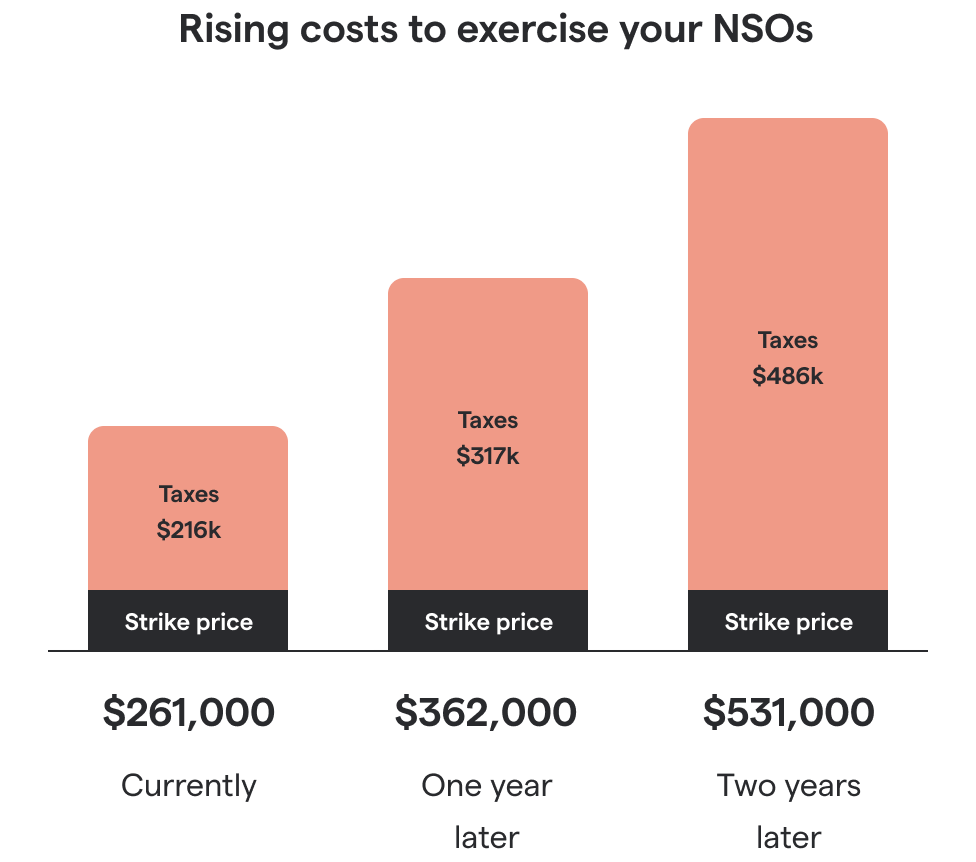
Exploding exercise costs effectively locks you out from exercising your NSOs. This is especially a problem at high-growth startups.
Warning #3: exercising NSOs can push you into a higher tax bracket
Reading the above examples, you might think: “Wait, 35-52%? I live in California and my income taxes never reach 35%.”
The problem is your NSO phantom gain counts as income on top of your salary.
If your annual salary is $200,000 but your phantom gain is $480,000, in the year you exercise your NSOs you’ll owe tax as if you’ve made $680,000.
This will push you into the higher tax brackets and can lead to an effective tax rate as high as 52%.
Tip: if your employer allows early exercising, you can exercise tax-free
A higher 409A valuation means more taxes, but this also works the other way around. A lower 409A means less taxes.
And if the 409A is equal to your strike price, you pay no taxes at all (because your phantom gain is zero).
That’s exactly the case when you’re first granted your NSOs because your strike price is based on the 409A valuation at the time. So if you exercise before the 409A valuation goes up, it’s effectively tax-free upfront.
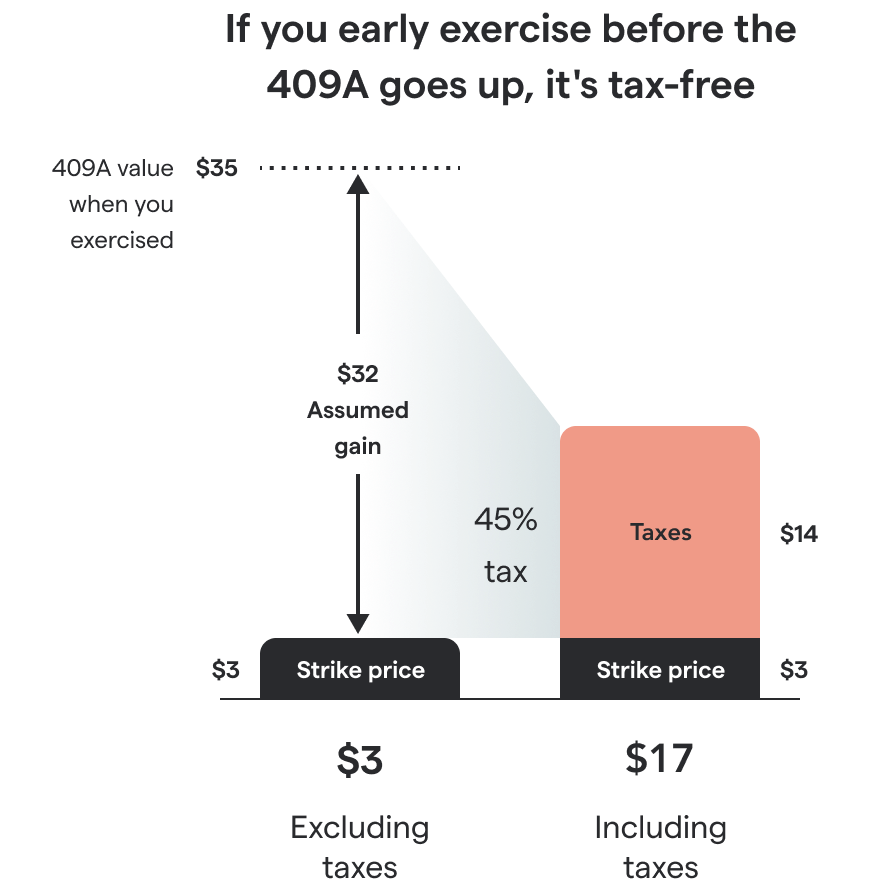
You can only do this if your company allows early exercising, or exercising options before they vest.
At most companies, you’ll have to wait for your NSOs to vest instead, by which time it’s likely the 409A has already increased.
Warning: if you early exercise, you need to file an 83(b) election with the IRS within 30 days. This makes it official. If you forget to file it, you’ll still be taxed when your NSOs vest in the future.
Use an NSO tax calculator to figure out your exact tax burden
In the above, we’ve used an effective tax rate of 45%, which is what we’re often seeing among our clients in California. But it really depends on:
- Where you live
- How you file your taxes
- Your household income
- Your phantom gain (i.e. the number of NSOs you exercise, their strike price, and the 409A valuation)
- A lot of other factors
If you want a personalized figure, use our Stock Option Tax Calculator. It’s completely free. Just create an account, enter your tax and equity details and it runs the numbers for you.
How are NSOs taxed when you make money (i.e. sell them after an exit)?
When you make money by selling your equity in an IPO or acquisition, your gain is taxed.
In the worst case, it’s again taxed at ordinary income rates (the highest possible rate, just like your salary).
But under the right conditions, you get a discount.
The amount of tax you owe depends on two things:
1. Did you exercise your NSOs at least a year before selling them?
2. If so, what was the 409A valuation at the time?
If you answer #1 with no, you’re taxed at ordinary income rates.
If you answer #1 with yes, you get a discount (called long-term capital gains). And the lower the 409A valuation was at the time, the higher the tax discount.
So – assuming you work for a company whose 409A valuation keeps rising – the earlier you exercise your NSOs, the higher your net gain in case of a successful exit.
Here’s how it works:
When you exercise, you’re taxed on your phantom gain (a.k.a. spread) – the difference between the strike price of the NSO, and the 409A valuation at the time.
But if your company goes on to have a successful exit, hopefully, you’ll sell your share for an amount higher than that 409A. So your actual gain is more than that initial phantom gain you paid taxes over.
Your remaining gain now gets taxed, too.
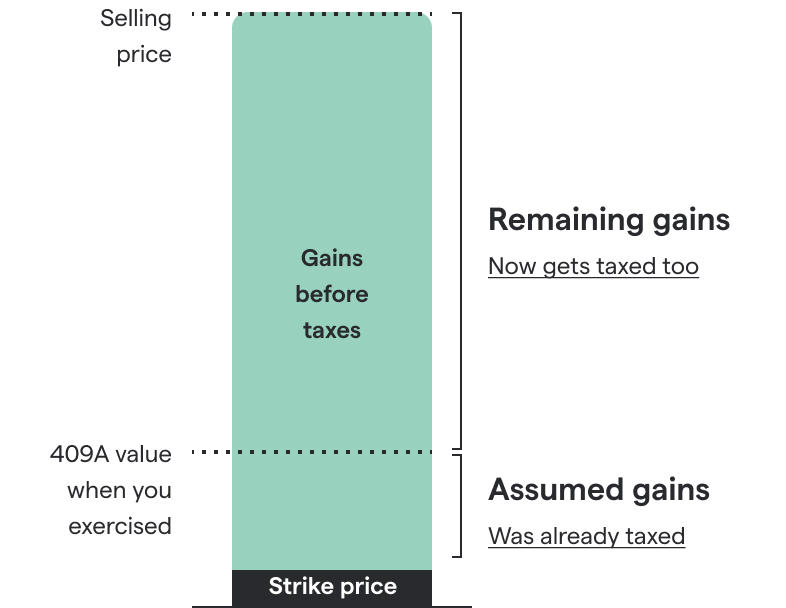
But at what rates? It depends on when you exercised:
- Long-term capital gains rates if you exercised at least a year prior (best case)
- Ordinary income rates if you didn’t (worst case)
Let’s go through both cases step by step.
If you didn’t exercise at least a year prior: ordinary income rates
This is the worst tax case.
Your remaining gain is taxed at the same rate as your phantom gain earlier.
This means, effectively, your full pre-tax gain (the selling price minus the strike price) is taxed at the highest possible rates, and your net gain is the same regardless of whether and when you exercised (or what the 409A valuation was at the time).
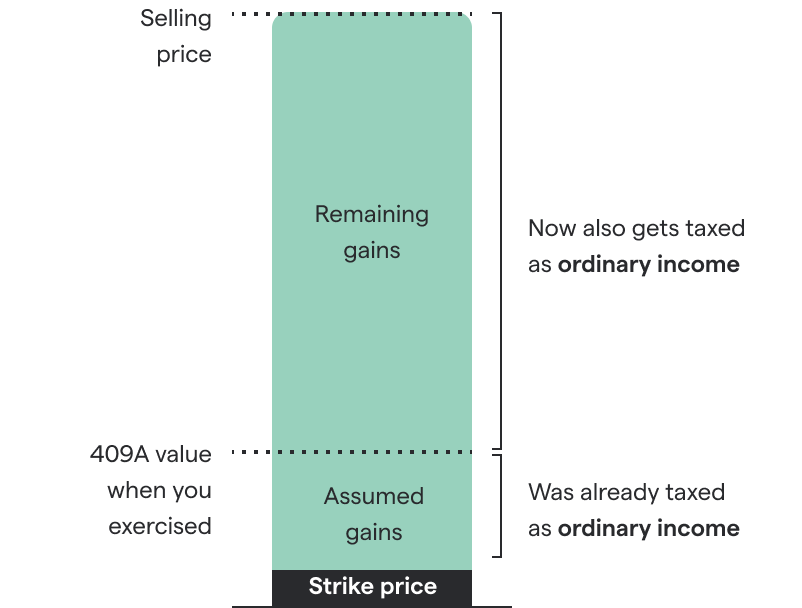
Here’s a real-world example
Say you again have these 15,000 NSOs at the $3 strike price. You exercised them when the 409A was $35. After the IPO you can sell them for $150 each.
However, the IPO was less than a year from when you exercised, so you don’t get the tax discount.
Now the situation is this:
- Before taxes, you make a $147 gain on each NSO you sell ($150 − $3 strike price)
- $32 of that $147 was already taxed when you exercised
- Of the remaining $115, you now owe $52 in ordinary income taxes ($115 × 45%)
- You’ve made a $81 net gain on your NSO ($150 − $52 sale tax − $17 exercise cost)
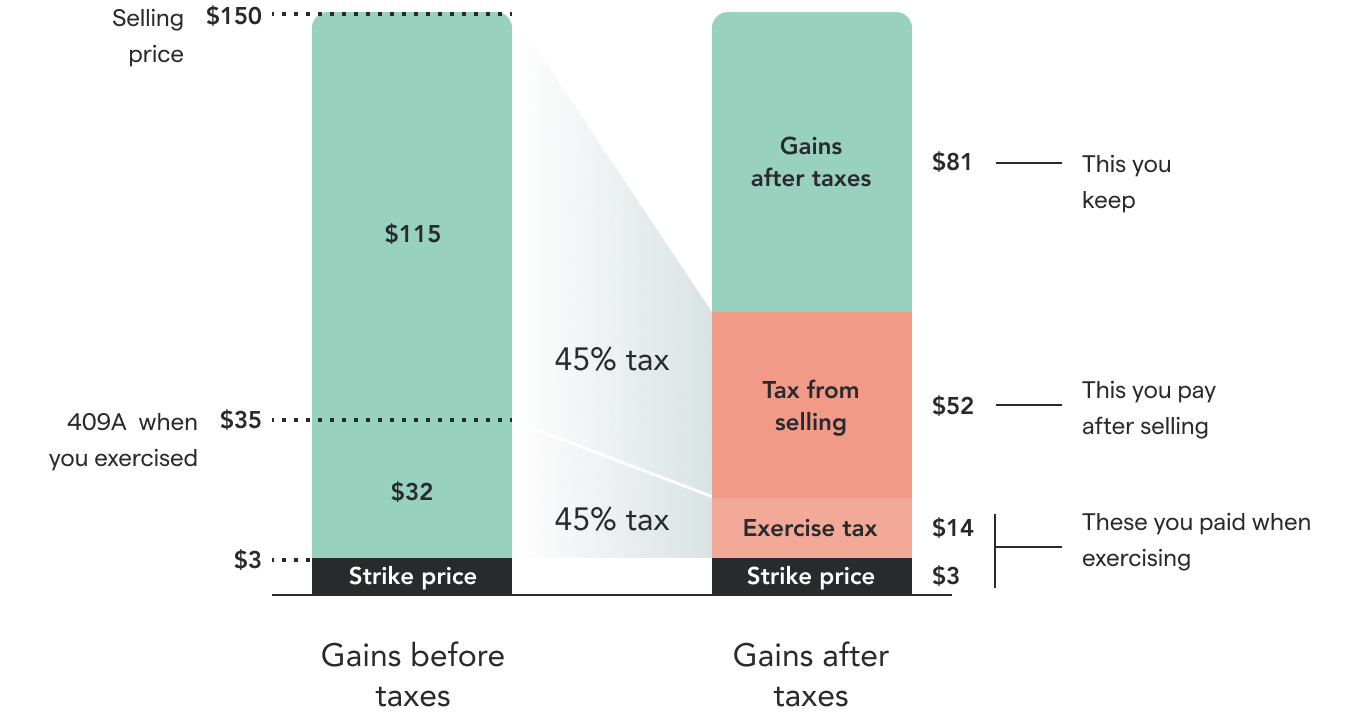
If you sell all of your 15,000 NSOs, then:
- You already paid $261,000 when you exercised
- You now sell your shares for a $2,250,000 payout (15,000 × $150)
- You owe $776,250 in taxes from selling
- Your net gain is $1,212,750
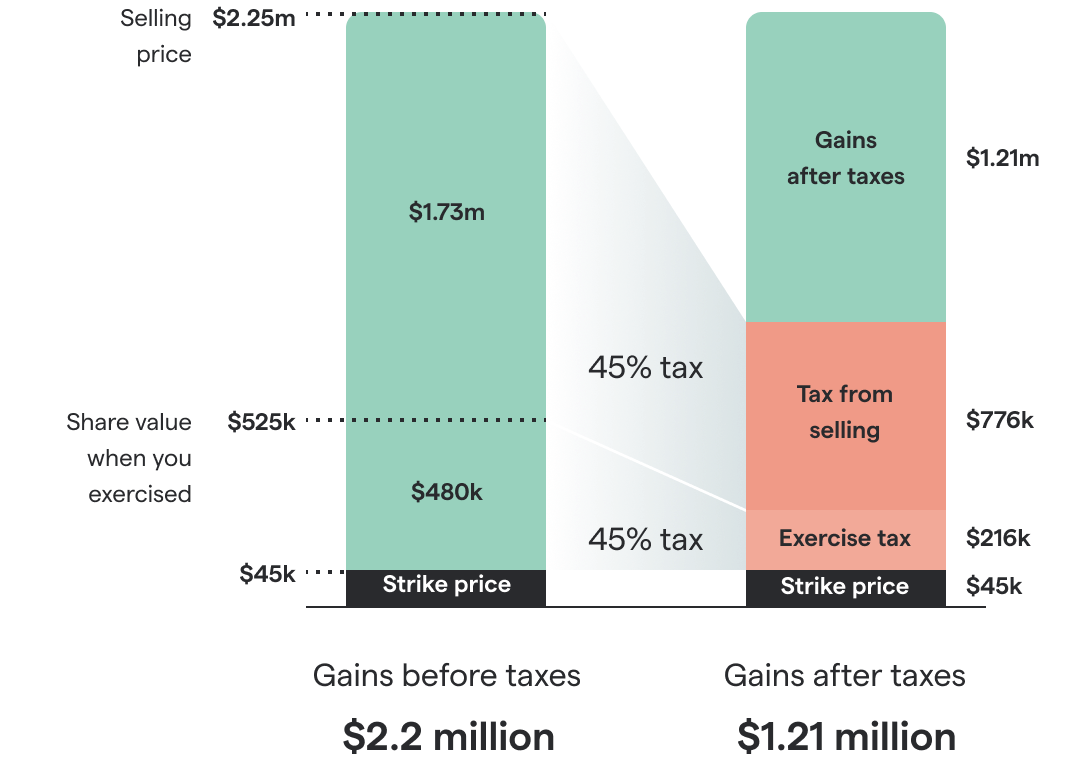
If you exercised at least a year prior: long-term capital gains rates
This is the best tax case.
Your remaining gain is taxed at long-term capital gains rates, which is lower than ordinary income rates. This means your net gain is higher and you maximize your NSO earnings.
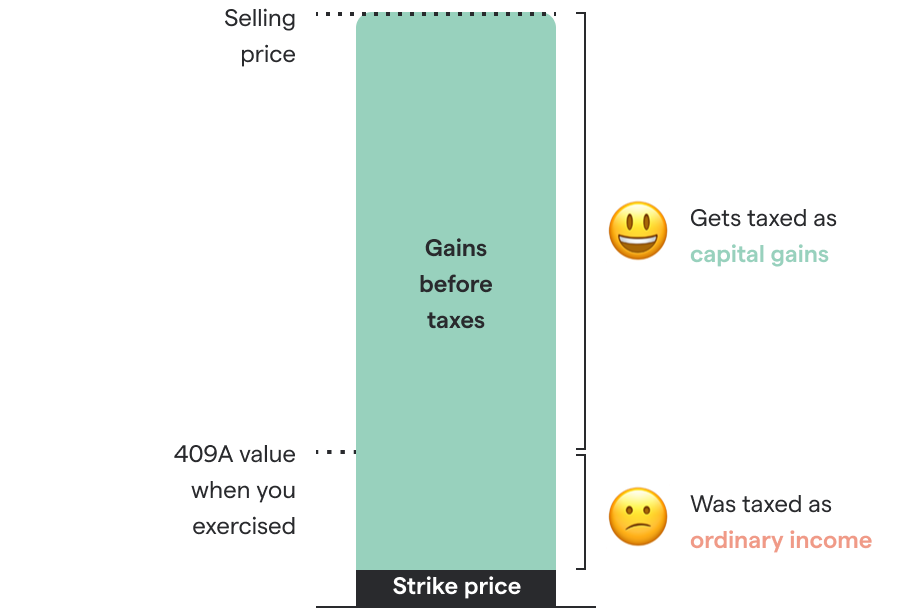
And the earlier you exercise, the higher your net gain.
That’s because exercising earlier means the 409A at the time was lower, so your phantom gain was smaller and your remaining gain larger.
In other words, a bigger chunk of your gross gain now falls under those favorable long-term capital gains tax rates:
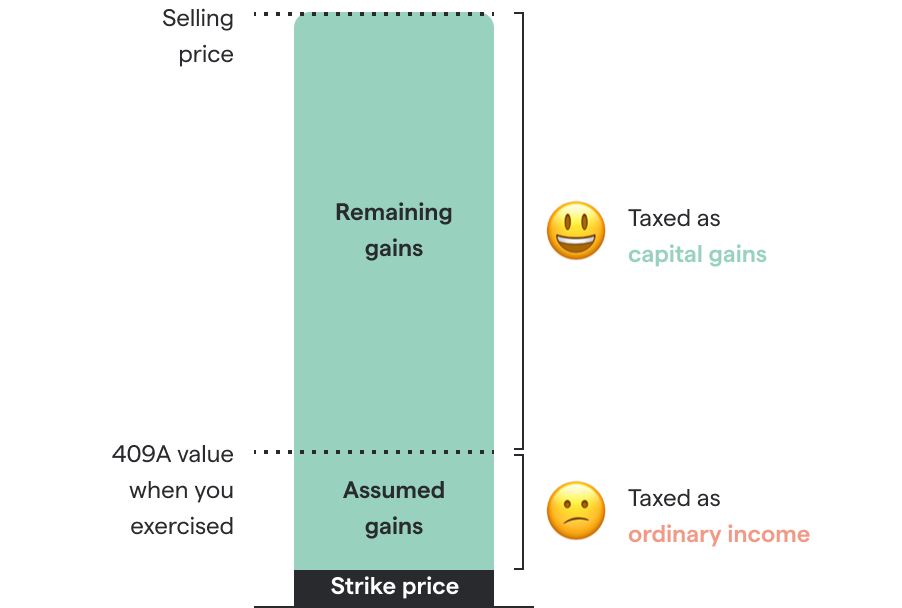
The effective tax rate depends on your personal situation – we’ll use 30% in this article.
Assuming 30%, this is how the timing of your exercise (and the 409A value at that time) affects your net gain:
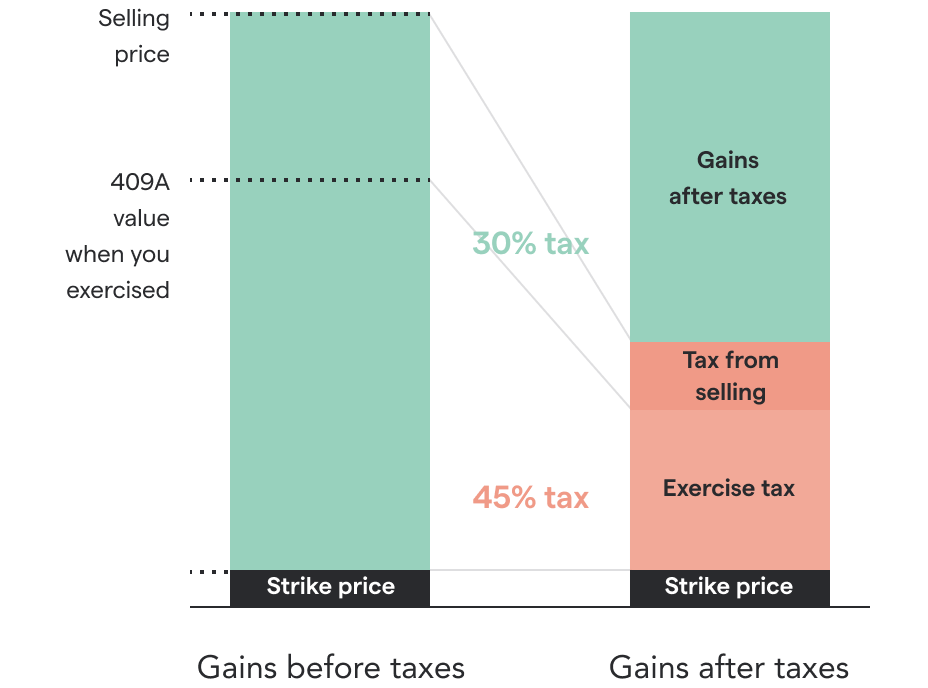
Here’s a real-world example
Let’s take the same scenario as before:
You have 15,000 NSOs at a $3 strike price, you exercised them when the 409A valuation was $35 and now sell them for $150.
Except this time, let’s assume you exercised more than 12 months before your sale, so your remaining gain gets taxed as long-term capital gains.
Then:
- Before taxes, your gain is $2,205,000 ($2,250,000 − $45,000 total strike price)
- $480,000 of that pre-tax gain was already taxed as phantom gain when you exercised
- Over the remaining $1,725,000, you now owe $776,250 in taxes ($1,725,000 × 30%)
- After taxes, your NSO gain is $1,471,500
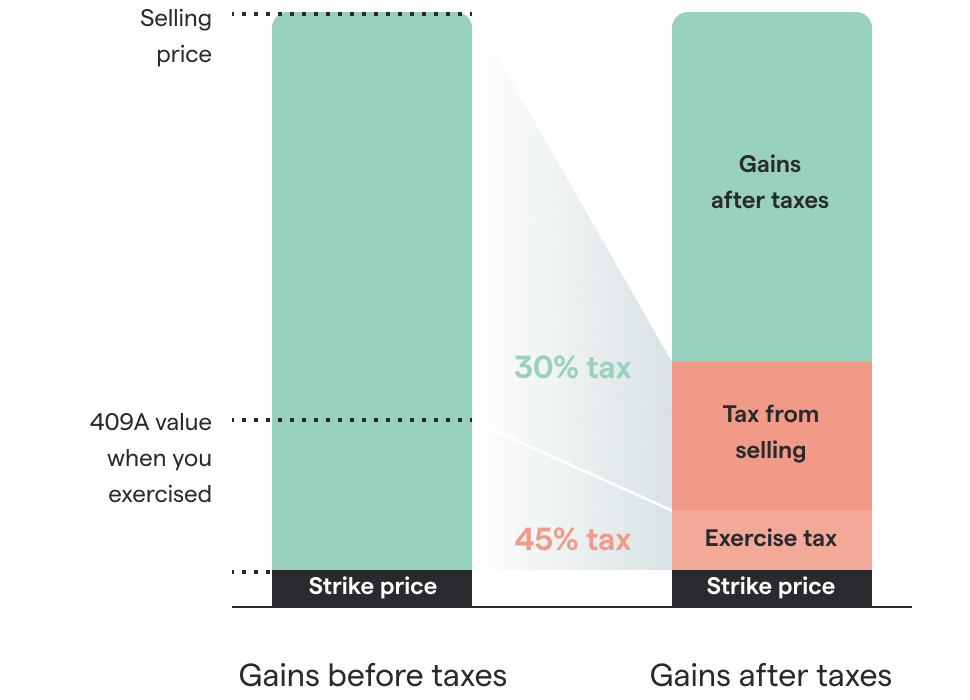
The benefit of long-term capital gains rates
In the examples above, getting the long-term capital gains tax rates meant taking home an additional $258,750 after taxes.
That’s a 21% increase.
Your effective tax rate dropped from 45% to 33% (rather than 30%, because you still paid the higher ordinary income rates over your phantom gain).
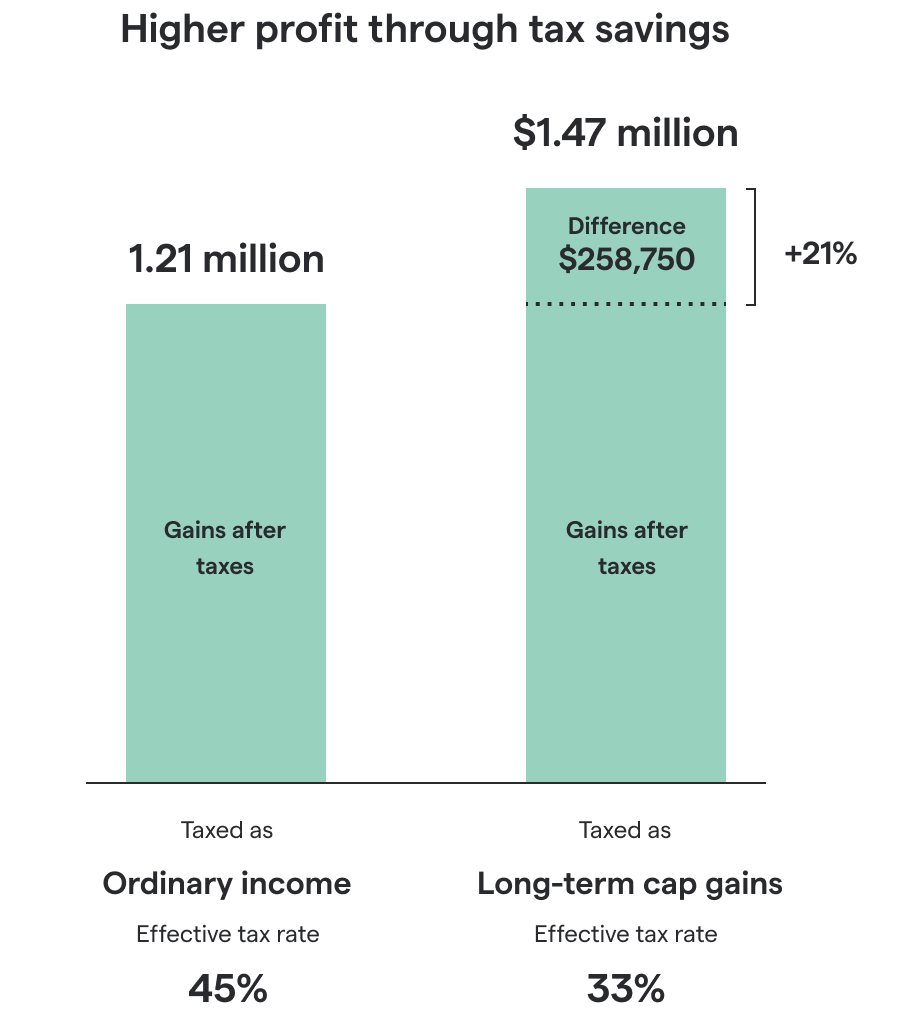
This tax savings can make a big difference in practice. See these Snowflake and DoorDash case studies for real-life examples.
How are NSOs taxed when you exercise and sell at the same time (i.e. a cashless exercise)?
Stock options are often explained as:
1. You first pay money to exercise them, buying you a share
2. Then, later, you sell that share at a gain (hopefully)
But #1 and #2 can happen at the same time – you buy the share, then immediately sell it. It’s as if you directly sold the NSO (rather than a share).
Of course, you can only do this if you wait until your company exits (otherwise its shares aren’t sellable).
This is called a cashless exercise since you never actually have to come up with the cash to cover the exercise costs.
You immediately make money — the immediate costs are withheld from your proceeds — and you’re guaranteed to have enough cash to cover any taxes later on.
Waiting for an exit to do a cashless exercise is a popular strategy because exercising prior to the exit can be expensive and risky (after all, there’s no guarantee of a successful future exit).
But what does that mean tax-wise?
With a cashless exercise, the two taxable events – exercising and selling – blend into one. This means you don’t get the tax savings of long-term capital gains (after all, you didn’t exercise at least a year prior to selling.)
Instead, you pay the higher ordinary income tax rates over your full gain (i.e. the price you sell your NSOs for, minus their strike price):
